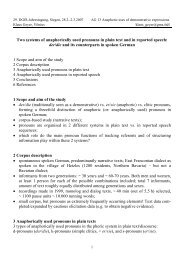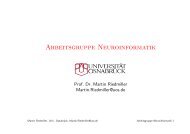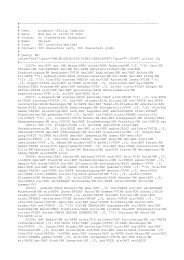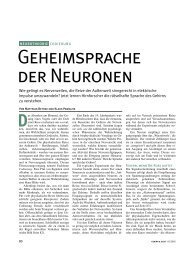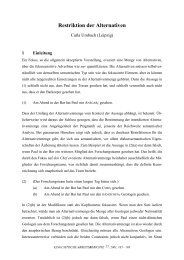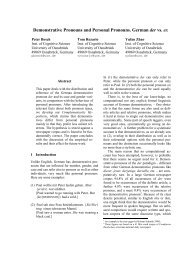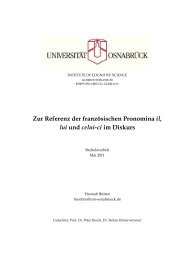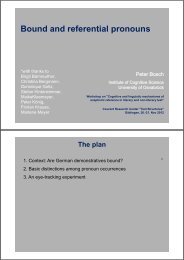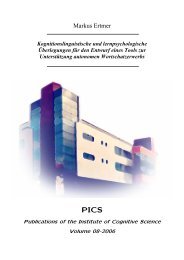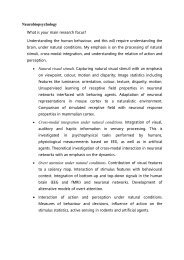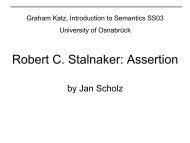Proceedings of the 6th Annual Meeting of the - Heinrich-Heine ...
Proceedings of the 6th Annual Meeting of the - Heinrich-Heine ...
Proceedings of the 6th Annual Meeting of the - Heinrich-Heine ...
You also want an ePaper? Increase the reach of your titles
YUMPU automatically turns print PDFs into web optimized ePapers that Google loves.
o<strong>the</strong>r hand, Booij gives some examples <strong>of</strong> coordinate structures like mono- en dialogen ‘monologues<br />
and dialogues’, where morphological structure does not lead us to expect that <strong>the</strong> element<br />
outside <strong>the</strong> coordinate structure is a prosodic word. If <strong>the</strong> requirement on coordination in Dutch<br />
is <strong>the</strong> same as I have suggested for English, namely that <strong>the</strong>re just be a foot boundary between<br />
<strong>the</strong> coordinate and non-coordinate parts, <strong>the</strong>n all <strong>the</strong> data are accounted for.<br />
The situation in German may be more complicated—I know <strong>of</strong> at least some speakers who refuse<br />
to accept *Mono und Dialoge, even though <strong>the</strong>re is a foot boundary between <strong>the</strong> coordinate and<br />
non-coordinate parts; a foot boundary may not be enough for <strong>the</strong>se speakers. Höhle (1982) gives<br />
an analysis <strong>of</strong> coordination in German in terms <strong>of</strong> morphological boundaries, but notes (fn. 8,<br />
p. 91) that <strong>of</strong>ten <strong>the</strong>se boundaries do not correlate with o<strong>the</strong>r phonological or morphological<br />
tests, and may in some cases lead to speaker variation and underdetermination. A prosodic explanation<br />
to speaker variation may be that in German <strong>the</strong> minimal boundary for coordination<br />
<strong>of</strong> word parts is that <strong>of</strong> a prosodic word ra<strong>the</strong>r than a foot, and variation stems from different<br />
speakers having different prosodic representations for <strong>the</strong> same words. Variation may also be<br />
<strong>the</strong> result <strong>of</strong> different speakers requiring different boundaries—some speakers only allow coordination<br />
<strong>of</strong> parts <strong>of</strong> words with a prosodic word boundary, while o<strong>the</strong>rs are content with a foot<br />
boundary. I leave <strong>the</strong> matter unresolved, pending fur<strong>the</strong>r data.<br />
4 Surface coordination vs. deletion<br />
Our <strong>the</strong>ory now has two parts: a semantic <strong>the</strong>ory for <strong>the</strong> interpretation <strong>of</strong> coordination on parts<br />
<strong>of</strong> words, and phonological restrictions on <strong>the</strong> structures that can be coordinated. These phonological<br />
observations draw on previous analyses <strong>of</strong> similar constructions in Dutch and German,<br />
which preferred to view <strong>the</strong>se constructions as resulting from a process <strong>of</strong> phonological deletion,<br />
ra<strong>the</strong>r than coordination at surface level (Höhle 1982; Booij 1985; Wiese 1992, 1996; Kleinhenz<br />
1997; Smith 2000). Our motivation for an analysis <strong>of</strong> surface coordination was <strong>the</strong> difference in<br />
meaning between NPs with coordinate word parts (ortho and periodontists) and coordinations<br />
<strong>of</strong> full NPs (orthodontists and periodontists). In this section I look at additional arguments that<br />
compare surface coordination with phonological deletion.<br />
The rule <strong>of</strong> deletion, as it is put forward in Booij (1985) and Kleinhenz (1997), includes a syntactic<br />
component as well as a phonological component. Deletion itself is phonological—<strong>the</strong> deleted<br />
element is a prosodic word. But prosodic restrictions alone do not predict <strong>the</strong> following contrasts,<br />
since in each pair <strong>the</strong> two structures are identical in terms <strong>of</strong> prosodic structure.<br />
(38) a. de land- en de tuinbouw<br />
‘<strong>the</strong> agriculture and <strong>the</strong> horticulture’<br />
b.*de land- met de tuinbouw<br />
‘<strong>the</strong> agriculture with <strong>the</strong> horticulture’<br />
(Dutch, Booij 1985)<br />
(39) a. eine elf- und eine zwölfjährige<br />
an eleven and a twelve-year-old<br />
b.*eine elf- bewundert eine zwölfjährige<br />
an eleven admires a twelve-year-old<br />
(German, Kleinhenz 1997)<br />
These examples lead Booij and Kleinhenz to conclude that <strong>the</strong> context for deletion must be syntactic:<br />
<strong>the</strong> deleted element has to be adjacent to a conjunction.<br />
A question which is not addressed is why this particular deletion rule should exist and not, say,<br />
a rule that allowed phonological deletion, under identity, subject to adjacency to a preposition.<br />
11



